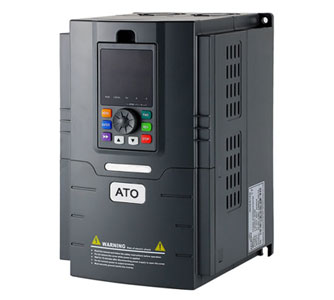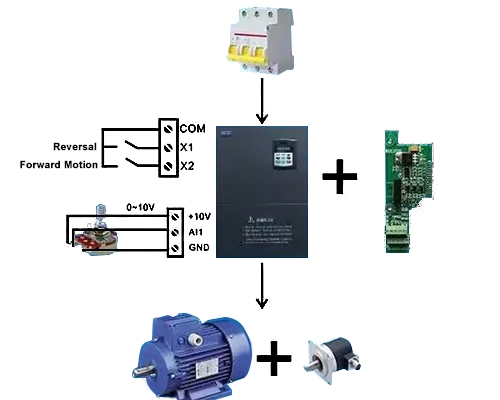The frequency inverter is a power control equipment that applies frequency conversion technology and microelectronics technology to control AC motors by changing the frequency inverter of the motor's working power supply. The frequency converter can realize precise motor speed control by adjusting the voltage and frequency of motor input. Frequency inverter plays a key role in industrial, commercial, and domestic applications, the inverter shop will explain in detail why we need frequency inverters.
The frequency inverter mainly consists of a rectifier (AC to DC), filter, inverter (DC to AC), braking unit, drive unit, detection unit microprocessor unit, and so on. Frequency converter relies on the internal IGBT on and off to adjust the output power supply voltage and frequency, according to the actual needs of the motor to provide the required power supply voltage, and then achieve the purpose of energy saving and speed regulation, with the increasing degree of industrial automation, the frequency converter has also been very widely used.
Energy Saving and Efficiency
A major reason is that frequency inverters can significantly improve the energy efficiency of the motor. In traditional motor control systems, motors usually run at a constant speed, but very often the load on the motor is constantly changing. This leads to wasted energy as the motor consumes additional energy to maintain a constant speed.
Frequency inverters allow the motor to adjust its speed as needed to match the actual load demand. This means that the motor will only use as much energy as is required, resulting in lower energy costs and less negative impact on the environment. Frequency converters smooth the starting current of the motor, reducing inrush currents and voltage fluctuations in the power system and avoiding transient voltage drops on the grid. That helps to reduce load fluctuations in the grid and improves grid stability and reliability.
Load Adaptability
In many applications, load requirements change over time. For example, a pump may need to operate at different flow requirements, or a fan may need to operate at different airflow requirements. Frequency inverters can dynamically adjust the speed of the motor to meet different load requirements. The adaptability makes the system more flexible and provides better performance and control. The frequency inverter is highly programmable and can be adjusted and configured to meet specific needs. This way allows operators to better control the system and achieve greater safety.
Energy Saving and Consumption Reduction
The frequency converter can dynamically adjust the motor speed and load as needed to adapt to the actual work requirements. Frequency inverters avoids unnecessary energy waste and significantly reduces power consumption. Especially under constant load, significant energy savings can be achieved by reducing the motor's operating speed. By reducing energy wastage, the frequency converter helps to reduce greenhouse gas emissions and minimize the negative impact on the environment. It is in line with sustainability objectives and environmental regulations.
Conventional motor systems typically produce high levels of noise and vibration when running below rated speeds, or when starting and stopping. Frequency inverters allow motors to run at low speeds. By using frequency inverters, smooth starting and stopping can be achieved, which reduces noise and vibration, and improves the comfort and safety of the working environment.
Soft Start and Stop
Conventional motor starting and stopping usually require sudden application or cut-off of current, which can lead to shocks and wear and tear on the motor and mechanical systems. Frequency inverters allow motors to realize soft starting and stopping. By reducing the shock and stress during motor starting and gradually increasing or decreasing the speed of the motor, which reduces shock and wear, frequency converters can extend the life of motors and mechanical equipment. Inverters also reduce motor overheating and wear, which means lower maintenance costs for equipment and mechanical systems because motors are replaced and repaired less frequently.

Precise Speed Control
In many industrial applications, precise speed and torque control are critical. Frequency inverters enable precise motor speed control, making production processes more stable and controllable. It is important for machining, production, and transportation processes that require high precision. In some applications, very precise speed control is required, such as robots on production lines, medical equipment, and laboratory instruments. Frequency inverters can provide highly accurate speed control, enabling precision operations and production in these applications.
Automation Control
Modern frequency inverters are designed for high reliability and durability and can operate in a wide range of industrial environments. The frequency converters often feature a wide range of protection features to ensure the safe operation of motors and equipment. Frequency inverters are integrated with modern automation systems and can be remotely monitored and controlled via a computer or PLC (Programmable Logic Controller). This makes the production process more intelligent and automated. Frequency inverters can be applied to various types of motors, including induction, synchronous, and permanent magnet synchronous motors. Frequency converters can also be used for different applications such as pumps, fans, compressors, conveyor belts, and winders.
All in all, frequency inverters are indispensable equipment for modern industrial and commercial applications to improve energy efficiency, production quality, and equipment reliability. Also, the use of frequency inverters helps to reduce the impact on the power grid. The importance of inverters is increasing with the growing concern for the sustainability of energy and resources. Frequency converters are an indispensable technology in modern industry and commerce, helping to meet the requirements of energy conservation and environmental protection while improving productivity and automation.
